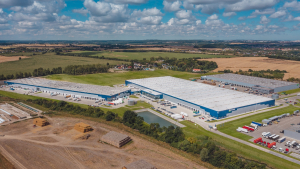
In 2022, the Polish office market recorded a strong performance in terms of demand for office space which came predominantly from the financial, IT and business services sectors. Meanwhile, development activity slowed down amid rising construction costs and the deteriorating economic backdrop. This will result in a ‘supply gap’ in the largest regional city office markets and Warsaw alike, says Cushman & Wakefield in its latest report.
After three years of turmoil the Polish office market is now entering a period of stability. 2023 marks three years since the onset of the Covid-19 pandemic and one year since Russia’s invasion of Ukraine. Against this backdrop, the office sector has been concerned whether the accumulation of these events could blow the Polish market off course more seriously than the 2008 financial crisis.
“At that time, however, Poland’s office stock was three times smaller than today. In 2022, the Polish office market owed its strength to transactions finalized by tenants with a long-standing presence in Poland. Despite the lack of a common decision-making pattern for organisations, they helped the market emerge from a period of destabilisation unscathed. Occupier activity comprising renegotiations, expansions and relocations amounted to over 1.4 million sqm, on par with the results recorded in the last eight years. Contrary to appearances, absorption was by no means low as the volume of new leases and expansions was only 10% shy of the pre-pandemic level, which bodes well for the coming quarters. A number of interesting developments are on the cards for this year and in the next years as the market continues on its path to further stabilisation. Most importantly, they include differences between individual city office markets and the expected slowdown in supply growth in Warsaw in 2023 and in regional cities in 2024. Office rents are expected to rise further this year, with rental growth most notable in central locations and impacting the dynamics of the whole market,” says Michał Galimski, Head of Regional Markets, Cushman & Wakefield.
Office demand bounces back post-pandemic
In 2022, total occupier activity in Warsaw amounted to over 860,000 sqm, up by over 33% on 2021 and only 2% lower than pre-pandemic 2019’s record performance. Total leasing activity in Poland’s regional city office markets hit more than 623,000 sqm, a 5% increase on 2021 but still 9% lower than in 2019.
“The robust office take-up in Warsaw was powered by several factors: both the accumulation of large-scale deals by tenants from the financial, business services and IT sectors and the overall growth in occupier demand for modern office space. The strong leasing activity in regional cities was driven by the continued expansion of the business services sector, which accounts for a substantial proportion of tenants there,” comments Katarzyna Lipka, Head of Consulting and Research, Cushman & Wakefield.
Office stock heads towards 13 million sqm
At the end of Q4 2022, the total office stock of Poland’s nine largest markets exceeded 12.7 million sqm. From October through to December 2022, only 8,700 sqm came on stream in Warsaw through one project: the DPD HQ (8,700 sqm, PID Polska). The total new office supply for the whole of 2022 was close to 237,000 sqm, 10% below the five-year average. In Q4 2022, regional cities reported 12 office completions with a combined area of almost 74,000 sqm, the largest being in Krakow: Echo Investment’s Brain Park A and B (13,900 sqm and 17,900 sqm, respectively) and Inter-Bud’s Fabryczna Office Park B4 and H1 (12,200 sqm and 9,600 sqm, respectively). Last year’s regional office supply totalled more than 405,000 sqm, 5% lower than the five-year average.
Development activity trends downwards
Poland’s office development pipeline has shrunk significantly over the last three years due to the completion of office projects that had previously broken ground, with new developments being reined in. This is a notable trend in Warsaw, where only around 181,500 sqm is currently under construction compared to close to 750,000 sqm in early 2020. Office stock under construction in regional cities amounts to approximately 410,000 sqm, marking more than a twofold decrease from the pre-pandemic 850,000 sqm.
“The subdued development activity in regional cities has been caused by rising office construction and fit-out costs and the overall economic downturn in Poland and globally. Looking ahead, we anticipate new office supply in regional cities to total 330,000 sqm in 2023, 20% lower than the average for the last five years. This is likely to spark a supply gap in regional cities in 2024, about 12 months later than in Warsaw,” says Jan Szulborski, Office Market Expert, Cushman & Wakefield.
The Warsaw office market is expected to expand by around 66,000 sqm this year, which will mark the start of a ‘supply gap’ that could last until 2025.
Rents remain under upward pressure
At the end of Q4 2022, Poland’s overall vacancy rate stood at 13.5%, down by 0.2 pp on Q3 2022 but up by a mere 0.1 pp compared to Q4 2021, indicating stable vacancy levels throughout 2022. Office availability in all the surveyed office markets amounted to 1.71 million sqm, representing a 5% increase compared to year-end 2021. Prime office rents in the regional cities averaged €12.50-15.50/sqm/month.
“We have observed that projects in the pipeline are currently experiencing the strongest upward pressure on office rents due to their significant exposure to rising construction and fit-out costs. This will cause landlords to rethink their pricing strategies depending on the location, quality and occupancy levels of their building portfolios,” concludes Vitalii Arkhypenko, Office Market Expert, Cushman & Wakefield.



